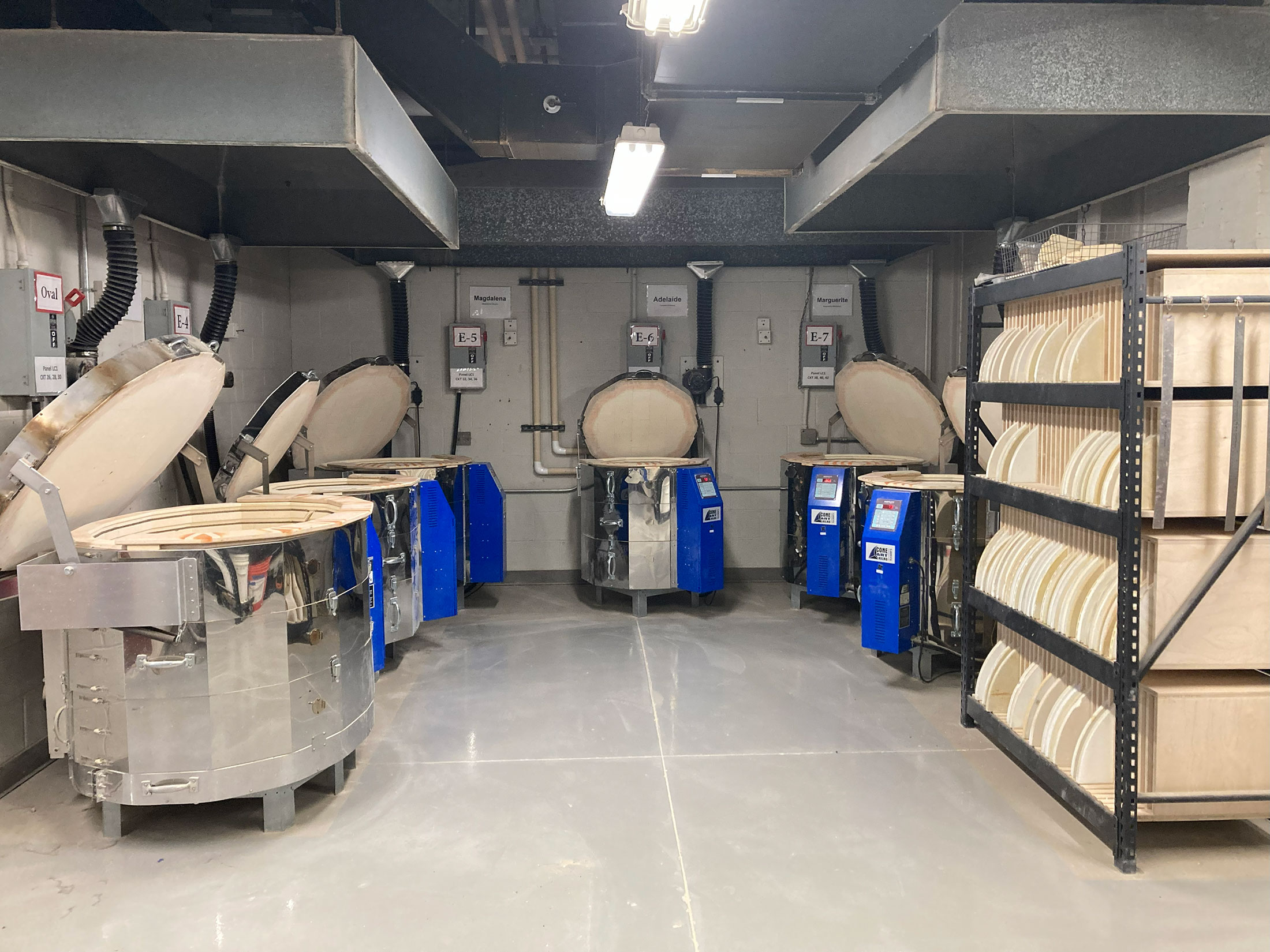
Program Features
BFA and BFA
Undergraduate students in Ceramics will be introduced to a range of possibilities in forming and firing technologies that include both pottery making and sculptural work in clay. Undergraduate students can take specialty courses alongside Ceramics graduate students in kiln building, clay and glaze formulation, and the history of ceramics. With rigorous classes, ample exhibition opportunities, and studio tech responsibilities, we prepare our BFA students for artist residencies, assistantships, apprenticeships, post-baccalaureate programs, and internships leading to a professional career or graduate study.
Inspiring, Comprehensive Facilities
Located in Richards Hall, ceramics facilities include an indoor electric kiln room, a covered outdoor kiln pad, a glaze mixing kitchen, a well-ventilated clay mixing room, an organized tool and maintenance area and the “Boneyard” a collection of objects made by thirty years of visiting artists in Ceramics. Classes are held in spacious hand-building and wheel-throwing studios with dedicated space for advanced undergraduate students.
Prestigious Visiting Artists
In addition to the artists brought in by Clay Club, the Hixson-Lied Visiting Artist Series brings six to eight nationally known artists, including at least one ceramic artist, to campus each semester. There is ample opportunity for undergraduate students to interact directly with visiting artists in Ceramics, who each meet with both undergraduate and graduate students, present a series of demonstrations and give a lecture about their work at the Sheldon Museum of Art auditorium.
Clay Club
A Recognized Student Organization (RSO) and part of Student Leadership, Involvement, & Community (SLICE), the Clay Club is a thriving student group that has about thirty members, consisting of both undergraduate and graduate students. Clay Club holds two very successful sales each year where members sell their pottery and sculptures to the public. Most of the funds from these sales go directly to students, but a percentage of the revenue helps to support student travel to professional conferences and symposia like the National Council on Education in the Ceramic Arts (NCECA) Conference which is held in a different city each year. Clay Club also hosts two visiting artists in Ceramics each year. Other Clay Club activities include pizza-making parties, pot-luck dinner parties, and a bi-annual Throw-a-Thon.
Notable Courses
CERM 231: Beginning Ceramics: Wheelthrowing
Introduction to the making of ceramic art using the potter's wheel, with an overview of the history, aesthetics, and criticism of the ceramic vessel, focusing on high temperature glaze and firing.
CERM 232: Beginning Ceramics: Handbuilding
Introduction to the making of ceramic art with an overview of the history, aesthetics, and criticism, focusing on handbuilding techniques and low temperature materials.
CERM 331: Intermediate Ceramics: Pottery and the Vessel
Intermediate level work in ceramics focused on making pottery and vessel forms using high temperature materials. Development of wheel-throwing skills and high temperature firing.
CERM 434: Glaze Formulation
Practical and theoretical information to develop, mix, fire, and troubleshoot ceramic surfaces for pottery and sculpture.
CERM 435: Kiln Design and Construction
Design and build a kiln for firing pottery or sculpture.
CERM 436: Making History: History of Ceramics
Study of the history of ceramic art through focused research and recreation of individual objects.
Huskers Do Big Things
Internships, Residencies, and Summer Workshops
- The Lux Center for the Arts in Lincoln
- Anderson Ranch Arts Center in Snowmass Village, Colorado
- Arrowmont School of Arts and Crafts in Gatlinburg, Tennessee
- The Annual Women Working with Clay Symposium in Roanoke, Virginia
- The Advanced Student Project Network (ASPN) Residency Program at Red Lodge Clay Center in Montana
Careers
- University Professor
- Full Time Studio Artist
- Museum Curator
- Director of an Arts Center
- Education Director at an Art Center
- Community Arts Teacher
Graduate Schools
- Alfred University-New York State College of Ceramics
- University of Florida, Gainesville
- Arizona State University
- Doane College, Nebraska
- Parsons School of Design, New York
- The University of Maryland
Have Questions? We're Here to Help
If you have questions about the Ceramics, contact us.

- Contact Name
- Chris Watson
- Contact Title
- Director of Recruitment
- Phone
-
-
